杜甫全集
杜甫的诗词全集、诗集(1171首全)28
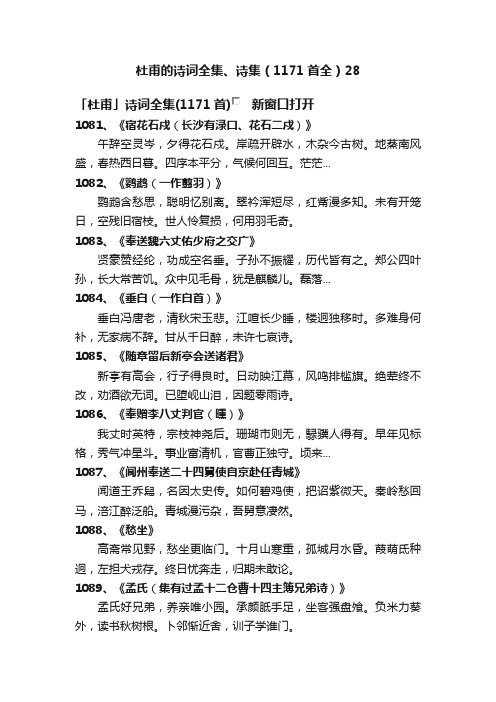
杜甫的诗词全集、诗集(1171首全)28「杜甫」诗词全集(1171首)新窗口打开1081、《宿花石戍(长沙有渌口、花石二戍)》午辞空灵岑,夕得花石戍。
岸疏开辟水,木杂今古树。
地蒸南风盛,春热西日暮。
四序本平分,气候何回互。
茫茫...1082、《鹦鹉(一作翦羽)》鹦鹉含愁思,聪明忆别离。
翠衿浑短尽,红觜漫多知。
未有开笼日,空残旧宿枝。
世人怜复损,何用羽毛奇。
1083、《奉送魏六丈佑少府之交广》贤豪赞经纶,功成空名垂。
子孙不振耀,历代皆有之。
郑公四叶孙,长大常苦饥。
众中见毛骨,犹是麒麟儿。
磊落...1084、《垂白(一作白首)》垂白冯唐老,清秋宋玉悲。
江喧长少睡,楼迥独移时。
多难身何补,无家病不辞。
甘从千日醉,未许七哀诗。
1085、《随章留后新亭会送诸君》新亭有高会,行子得良时。
日动映江幕,风鸣排槛旗。
绝荤终不改,劝酒欲无词。
已堕岘山泪,因题零雨诗。
1086、《奉赠李八丈判官(曛)》我丈时英特,宗枝神尧后。
珊瑚市则无,騄骥人得有。
早年见标格,秀气冲星斗。
事业富清机,官曹正独守。
顷来...1087、《阆州奉送二十四舅使自京赴任青城》闻道王乔舄,名因太史传。
如何碧鸡使,把诏紫微天。
秦岭愁回马,涪江醉泛船。
青城漫污杂,吾舅意凄然。
1088、《愁坐》高斋常见野,愁坐更临门。
十月山寒重,孤城月水昏。
葭萌氐种迥,左担犬戎存。
终日忧奔走,归期未敢论。
1089、《孟氏(集有过孟十二仓曹十四主簿兄弟诗)》孟氏好兄弟,养亲唯小园。
承颜胝手足,坐客强盘飧。
负米力葵外,读书秋树根。
卜邻惭近舍,训子学谁门。
1090、《吾宗(卫仓曹崇简)》吾宗老孙子,质朴古人风。
耕凿安时论,衣冠与世同。
在家常早起,忧国愿年丰。
语及君臣际,经书满腹中。
1091、《冬深(一作即日)》花叶随天意,江溪共石根。
早霞随类影,寒水各依痕。
易下杨朱泪,难招楚客魂。
风涛暮不稳,舍棹宿谁门。
1092、《惠义寺送王少尹赴成都(得峰字)》苒苒谷中寺,娟娟林表峰。
阑干上处远,结构坐来重。
杜甫诗词全集,大全
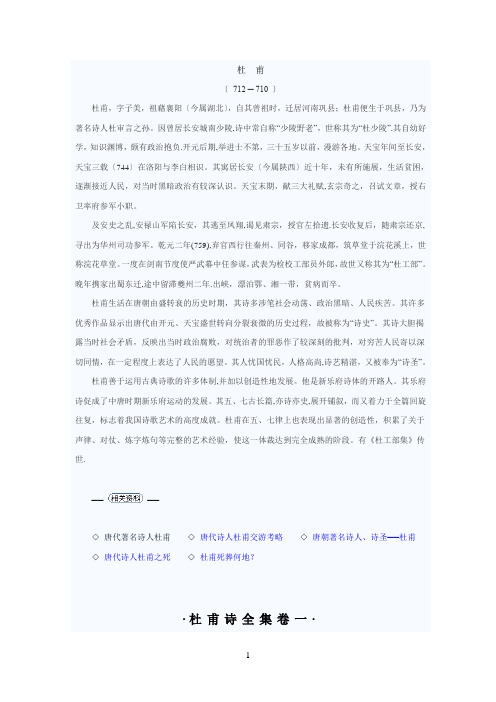
杜甫〔712 ─ 710〕杜甫,字子美,祖藉襄阳〔今属湖北〕,自其曾祖时,迁居河南巩县;杜甫便生于巩县,乃为著名诗人杜审言之孙。
因曾居长安城南少陵,诗中常自称“少陵野老”,世称其为“杜少陵”.其自幼好学,知识渊博,颇有政治抱负.开元后期,举进士不第,三十五岁以前,漫游各地。
天宝年间至长安,天宝三载〔744〕在洛阳与李白相识。
其寓居长安〔今属陕西〕近十年,未有所施展,生活贫困,逐渐接近人民,对当时黑暗政治有较深认识。
天宝末期,献三大礼赋,玄宗奇之,召试文章,授右卫率府参军小职。
及安史之乱,安禄山军陷长安,其逃至凤翔,谒见肃宗,授官左拾遗.长安收复后,随肃宗还京,寻出为华州司功参军。
乾元二年(759),弃官西行往秦州、同谷,移家成都,筑草堂于浣花溪上,世称浣花草堂。
一度在剑南节度使严武幕中任参谋,武表为检校工部员外郎,故世又称其为“杜工部”。
晚年携家出蜀东迁,途中留滞夔州二年.出峡,漂泊鄂、湘一带,贫病而卒。
杜甫生活在唐朝由盛转衰的历史时期,其诗多涉笔社会动荡、政治黑暗、人民疾苦。
其许多优秀作品显示出唐代由开元、天宝盛世转向分裂衰微的历史过程,故被称为“诗史”。
其诗大胆揭露当时社会矛盾,反映出当时政治腐败,对统治者的罪恶作了较深刻的批判,对穷苦人民寄以深切同情,在一定程度上表达了人民的愿望。
其人忧国忧民,人格高尚,诗艺精湛,又被奉为“诗圣”。
杜甫善于运用古典诗歌的许多体制,并加以创造性地发展。
他是新乐府诗体的开路人。
其乐府诗促成了中唐时期新乐府运动的发展。
其五、七古长篇,亦诗亦史,展开铺叙,而又着力于全篇回旋往复,标志着我国诗歌艺术的高度成就。
杜甫在五、七律上也表现出显著的创造性,积累了关于声律、对仗、炼字炼句等完整的艺术经验,使这一体裁达到完全成熟的阶段。
有《杜工部集》传世.── ──◇唐代著名诗人杜甫◇唐代诗人杜甫交游考略◇唐朝著名诗人、诗圣──杜甫◇唐代诗人杜甫之死◇杜甫死葬何地?·杜甫诗全集卷一·奉赠韦左丞丈二十二韵纨袴不饿死,儒冠多误身。
杜甫所有古诗大全集

杜甫所有古诗大全集杜甫一生创作了大量的古诗,其全集包含了众多脍炙人口的佳作。
一、早期作品- 原文:“岱宗夫如何?齐鲁青未了。
造化钟神秀,阴阳割昏晓。
荡胸生曾云,决眦入归鸟。
会当凌绝顶,一览众山小。
”- 解析:这首诗是杜甫早期的作品,那时他还是个充满朝气和抱负的青年。
诗一开头就问泰山怎么样啊,“岱宗夫如何”,这种提问就像我们今天看到一个超级厉害的东西,先发出惊叹的疑问。
“齐鲁青未了”,说在齐鲁大地上,泰山的青色绵延不绝,这就把泰山的雄伟写出来了,它的青色都能横跨齐鲁大地呢。
“造化钟神秀”,就好像大自然特别偏爱泰山,把所有的神奇秀丽都集中到它身上了。
“阴阳割昏晓”更是绝,山的南北两面就像被一把刀割开一样,一面是早晨,一面是黄昏,把泰山的高大给写活了。
“荡胸生曾云”,站在泰山下,看到山上层层叠叠的云,感觉自己的心胸都开阔了,云就像在自己的胸膛里飘荡一样。
“决眦入归鸟”,瞪大了眼睛看归巢的鸟儿,这是在写自己全神贯注地看泰山上的景色。
最后“会当凌绝顶,一览众山小”,这可是千古名句啊,表达了杜甫的雄心壮志,他说自己一定要登上泰山的顶峰,到时候看别的山都变得渺小了。
这就好比我们现在说要成为某个领域的顶尖人物,然后看其他人都不在话下一样。
- 原文:“秋来相顾尚飘蓬,未就丹砂愧葛洪。
痛饮狂歌空度日,飞扬跋扈为谁雄。
”- 解析:杜甫和李白有过交往,这首诗就是写给他的。
“秋来相顾尚飘蓬”,秋天的时候两人见面,都像飘飞的蓬草一样,没有定所,这是在说他们当时的生活状态,到处漂泊。
“未就丹砂愧葛洪”,他们也想求仙问道,像葛洪那样炼制丹药,但是没成功,感觉有点惭愧。
“痛饮狂歌空度日”,说他们整天喝酒唱歌,好像是在虚度光阴呢。
“飞扬跋扈为谁雄”,表面上看是在说他们这样放纵不羁是为了谁呢,其实是在感慨他们怀才不遇,有才华却没地方施展,只能这样借酒消愁、狂放不羁。
二、安史之乱时期作品- 原文:“国破山河在,城春草木深。
感时花溅泪,恨别鸟惊心。
杜甫诗全集目录

杜甫诗全集目录1.望岳 [杜甫]2.登楼 [杜甫]3.题张氏归隐 [杜甫]4.玉台观 [杜甫]5.同诸公尼里慈恩寺塔 [杜甫]6.无题 [杜甫]8.梅雨 [杜甫]9.题玄武禅师屋壁 [杜甫]10.大至 [杜甫]11.携妓纳凉晚际遇雨 [杜甫]12.新秋 [杜甫]13.野望 [杜甫]14.白露 [杜甫]15.白丝行 [杜甫]16.赤霄行 [杜甫]17.冬狩行 [杜甫]18.短歌行追赠王郎司直 [杜甫]19.茅屋为秋风所破歌 [杜甫]20.莫相疑行 [杜甫]21.石笋行 [杜甫]22.戏题王宰图画山水图歌 [杜甫]23.醉歌行赠公安颜少府,请顾八题壁 [杜甫]24.醉酒时歌 [杜甫]25.丹青引追赠曹霸将军 [杜甫]26.风雨看舟前落花,戏为新句 [杜甫]27.负薪行 [杜甫]28.低都护骢马行 [杜甫]29.古柏行 [杜甫]30.观公孙大娘弟子舞剑器行 [杜甫]31.晦日寻崔戢李封 [杜甫]32.递韩光禄 [杜甫]33.美陂行 [杜甫]34.楠树为风雨所拔感叹 [杜甫]35.清明二首 [杜甫]36.释闷 [杜甫]37.送孔巢父谢病归游江东,兼呈李白 [杜甫]38.韦讽录事宅观曹将军画马图 [杜甫]39.玄都坛歌寄元逸人 [杜甫]40.岳麓山道林二寺行 [杜甫]41.醉歌行 [杜甫]42.江南可逢李龟年 [杜甫]43.绝句 [杜甫] 44.夔州歌 [杜甫]45.三绝句 [杜甫]46.书堂饮既夜复邀李尚书下马月下赋绝句 [杜甫]47.戏为六绝句 [杜甫]48.赠花卿 [杜甫]49.哀江头 [杜甫]50.哀王孙 [杜甫]51.兵车行 [杜甫]52.乐游园歌 [杜甫]53.丽人行 [杜甫]54.曲江三章 [杜甫]55.白帝城最高楼 [杜甫]56.悲陈陶 [杜甫]57.悲青坂 [杜甫]58.卜居 [杜甫]59.览胜 [杜甫]60.春水生 [杜甫]61.葱笼 [杜甫]62.涪城县香积寺官阁 [杜甫]63.阁夜 [杜甫]64.光禄坂行 [杜甫]65.海棕行 [杜甫]66.和裴迪登蜀州东亭送客逢早梅相忆见寄 [杜甫]67.恨别 [杜甫]68.黄草 [杜甫]69.即事 [杜甫]70.递常徵君 [杜甫]71.江村 [杜甫]72.江畔独步寻花 [杜甫]73.江上值水如海势,聊短述 [杜甫]74.将前往成都草堂,途中有作,先寄严郑公五首 [杜甫]75.客至 [杜甫]76.狂夫 [杜甫]77.腊日 [杜甫]78.暮归属于 [杜甫]79.秋兴八首 [杜甫]80.秋雨叹三首 [杜甫]81.曲江对酒 [杜甫]82.曲江二首 [杜甫]83.曲江值雨 [杜甫]84.舍弟观赴蓝田挑妻子至江陵,晴递三首[杜甫]85.十一月一日三首 [杜甫]86.示獠奴阿段 [杜甫]87.蜀相 [杜甫]88.送来韩十四江东省觐 [杜甫]89.送郑十八虔贬台州司户,伤其临老陷贼之故,阙为面别,情载于诗 [杜甫]90.宿府 [杜甫]91.感叹庭前甘菊花 [杜甫]92.堂成 [杜甫]93.滕王亭子 [杜甫]94.题省中院壁 [杜甫]95.题桃树 [杜甫]96.奉和严郑公《军城早秋》 [杜甫]97.题郑县亭子 [杜甫]98.观李固请司马第山水图 [杜甫]99.闻官军交河南河北 [杜甫].小寒食舟中作 [杜甫].晓发公安 [杜甫].燕子来舟中作 [杜甫].野老 [杜甫].野人送朱樱 [杜甫].输水 [杜甫].咏怀古迹 [杜甫].渔阳 [杜甫].与朱山人 [杜甫].院中晚晴,怀西郭茅舍 [杜甫] .诸将五首 [杜甫].八哀诗 [杜甫].北风 [杜甫].北征 [杜甫].病柏 [杜甫].病桔 [杜甫].草堂 [杜甫].柴门 [杜甫].陈拾遗故宅 [杜甫].除草 [杜甫].春归 [杜甫].大云寺盛赞公房四首 [杜甫].到村 [杜甫].冬至金华山观,因得故补阙陈公学堂遗迹 [杜甫].和泛溪 [杜甫].奉同郭给事汤东灵湫作 [杜甫].奉赠韦左丞丈二十二韵 [杜甫].甘林 [杜甫].过郭代公故宅 [杜甫].后出塞五首 [杜甫].回去棹 [杜甫].寄题江外草堂 [杜甫].佳人 [杜甫].建都十二韵 [杜甫].九日寄岑弁 [杜甫].客居 [杜甫].课伐木 [杜甫].枯楠 [杜甫].玉露棕 [杜甫].苦雨奉寄陇西公,兼呈王徵士 [杜甫] .立秋日雨,院中有作 [杜甫].美陂西南台 [杜甫].梦李白 [杜甫].偶题 [杜甫].吃饭李北海宴历下亭 [杜甫].彭衙行 [杜甫].牵牛织女 [杜甫].遣闷奉呈严公二十韵 [杜甫].贾岛五首 [杜甫].遣遇 [杜甫].羌村三首 [杜甫].秋日夔府咏怀奉寄郑监李宾客一百韵 [杜甫].进衡州 [杜甫].伤春五首 [杜甫].上水遣怀 [杜甫].石壕吏 [杜甫].陆机三首 [杜甫].述怀 [杜甫].水槛 [杜甫].四松 [杜甫].送高三十五书记十五韵 [杜甫].送韦讽上阆州录事参军 [杜甫].宿清溪驿,奉怀张员外十五兄之绪 [杜甫].太子张舍人遗织成襦段 [杜甫].题衡山县文宣王庙崭新学堂,呈圆形陆宰 [杜甫] .同元使君舂陵行 [杜甫].和贾舍人早朝 [杜甫].潼关吏 [杜甫].无家别 [杜甫].九日蓝田会饮 [杜甫].新安吏 [杜甫].信行远修水筒 [杜甫].谒文公上方 [杜甫].义鹘行 [杜甫].题壁 [杜甫].与李十二白同寻范十隐居 [杜甫] .玉华宫 [杜甫].园官送菜 [杜甫].园人送来瓜 [杜甫].赠李白 [杜甫].母孟氏八处士 [杜甫].自京赴奉先县咏怀五百字 [杜甫] .棕拂子 [杜甫].八阵图 [杜甫].复愁 [杜甫].绝句二首 [杜甫].八月十五夜月二首 [杜甫].白小 [杜甫].悲秋 [杜甫].别房太尉墓 [杜甫].草堂即为事 [杜甫].赤谷西崦人家 [杜甫].初月 [杜甫].春日江村五首 [杜甫].春宿左省 [杜甫].春望 [杜甫].祠南夕望 [杜甫].尼里兖州城楼 [杜甫].登岳阳楼 [杜甫].丁香 [杜甫] .月夜 [杜甫].对雪 [杜甫].对雨书容,跑邀许主簿 [杜甫].恶树 [杜甫].房兵曹胡马诗 [杜甫].奉济驿重送严公四韵 [杜甫].高楠 [杜甫].公安县怀古 [杜甫].孤雁 [杜甫].官定后戏赠 [杜甫].花鸭 [杜甫].黄鱼 [杜甫].江汉 [杜甫].九日登梓州城 [杜甫].奈何夜 [杜甫] .可是 [杜甫].客从 [杜甫].客夜 [杜甫].课小竖锄斫舍北果林,枝蔓荒秽,净讫,移床三首 [杜甫] .老病 [杜甫].丽春 [杜甫].龙门 [杜甫].漫成二首 [杜甫].暮春题襄西新赁草屋五首 [杜甫] .鸥 [杜甫].陪郑广文游何将军山林十首 [杜甫] .屏迹三首 [杜甫].前出塞九首 [杜甫].秦州杂诗二十首 [杜甫].琴台 [杜甫].秋野五首 [杜甫].去蜀 [杜甫].收京三首 [杜甫].水槛遣心二首 [杜甫].送来元二婉江左 [杜甫].送远 [杜甫].天末怀李白 [杜甫].田舍 [杜甫].为农 [杜甫].畏人 [杜甫].西山三首 [杜甫].鸂鶒 [杜甫].晴达行在所三首 [杜甫].戏简郑广文兼呈苏司业 [杜甫].湘夫人祠 [杜甫].移居夔州郭 [杜甫].游龙门遣先寺 [杜甫].有感五首 [杜甫].雨 [杜甫].雨晴 [杜甫].禹庙 [杜甫].猿 [杜甫].月 [杜甫].月夜 [杜甫].月夜忆舍弟 [杜甫].暂如临邑,至蜡山湖亭,奉怀李员外,率尔成兴 [杜甫] .栀子 [杜甫].重过何氏五首 [杜甫].重题郑氏东亭 [杜甫].自阆州领妻子却赴蜀山行三首 [杜甫].杜甫诗全集-卷一 [杜甫].杜甫诗全集-卷二 [杜甫].杜甫诗全集-卷三 [杜甫].杜甫诗全集-卷四 [杜甫].杜甫诗全集-卷五 [杜甫].杜甫诗全集-卷六 [杜甫].杜甫诗全集-卷七 [杜甫].杜甫诗全集-卷八 [杜甫].漫兴 [杜甫]。
杜甫古诗大全300首小学

杜甫古诗大全300首全集目录杜甫古诗大全300首全集 (1)1、去矣行【唐代:杜甫】 (17)2、绝句四首.其四【唐代:杜甫】 (17)3、蜀相【唐代:杜甫】 (17)4、望岳【唐代:杜甫】 (17)5、与李十二白同寻范十隐居【唐代:杜甫】 (18)6、羌村三首.其三【唐代:杜甫】 (18)7、赠李白【唐代:杜甫】 (19)8、野望【唐代:杜甫】 (19)9、江上值水如海势聊短述【唐代:杜甫】 (19)10、武侯庙【唐代:杜甫】 (19)11、绝句二首.其二【唐代:杜甫】 (20)12、月夜【唐代:杜甫】 (20)13、月夜忆舍弟【唐代:杜甫】 (20)14、佳人【唐代:杜甫】 (20)15、昼梦【唐代:杜甫】 (21)16、古柏行【唐代:杜甫】 (21)18、前出塞九首.其六【唐代:杜甫】 (22)19、归梦【唐代:杜甫】 (22)20、归雁二首【唐代:杜甫】 (23)21、暮归【唐代:杜甫】 (23)22、喜达行在所三首【唐代:杜甫】 (23)23、杜位宅守岁【唐代:杜甫】 (24)24、忆昔二首【唐代:杜甫】 (24)25、后游【唐代:杜甫】 (25)26、客夜【唐代:杜甫】 (26)27、戏题寄上汉中王三首其一【唐代:杜甫】 (26)28、寄杨五桂州谭【唐代:杜甫】 (26)29、秦州杂诗二十首其一【唐代:杜甫】 (26)30、观李固请司马弟山水图三首其一【唐代:杜甫】 (27)31、观安西兵过赴关中待命二首其二【唐代:杜甫】 (27)32、熟食日【唐代:杜甫】 (27)33、晚秋长沙蔡五侍御饮筵送殷六参军归澧州觐省【唐代:杜甫】 (27)34、舟中夜雪有怀卢十四侍御【唐代:杜甫】 (27)35、奉赠韦左丞二十二韵【唐代:杜甫】 (28)37、遣兴三首其一【唐代:杜甫】 (28)38、鹦鹉【唐代:杜甫】 (29)39、奉赠萧二十使君【唐代:杜甫】 (29)40、秦州杂诗二十首其三【唐代:杜甫】 (29)41、八哀诗其五赠秘书监江夏李公邕【唐代:杜甫】 (30)42、偪仄【唐代:杜甫】 (31)43、公安送李二十九弟晋肃入蜀余下沔鄂【唐代:杜甫】 (31)44、送韦书记赴安西【唐代:杜甫】 (32)45、秦州杂诗二十首其十【唐代:杜甫】 (32)46、遣兴五首其四【唐代:杜甫】 (32)47、覆舟二首其二【唐代:杜甫】 (32)48、戏赠友二首其一【唐代:杜甫】 (32)49、南池【唐代:杜甫】 (33)50、陪柏中丞观宴将士二首其一【唐代:杜甫】 (33)51、奉送二十三舅录事【唐代:杜甫】 (33)52、西阁曝日【唐代:杜甫】 (34)53、绝句二首.其一【唐代:杜甫】 (34)54、春宿左省【唐代:杜甫】 (34)56、昔游【唐代:杜甫】 (35)57、棕拂子【唐代:杜甫】 (36)58、越王楼歌(太宗子越王贞为绵州刺史,作台于州城西北)【唐代:杜甫】. 3659、火【唐代:杜甫】 (36)60、观薛稷少保书画壁【唐代:杜甫】 (37)61、幽人【唐代:杜甫】 (37)62、寄裴施州(裴冕坐李辅国贬施州刺史)【唐代:杜甫】 (37)63、万丈潭【唐代:杜甫】 (38)64、夜闻觱篥【唐代:杜甫】 (38)65、冬狩行(时梓州刺史章彝兼侍御史留后东川)【唐代:杜甫】 (38)66、次空灵岸【唐代:杜甫】 (39)67、四松【唐代:杜甫】 (39)68、秋风二首【唐代:杜甫】 (40)69、戏赠友二首【唐代:杜甫】 (40)70、丈人山(山在青城县北,黄帝封青城山为五岳丈人)【唐代:杜甫】 (41)71、苏大侍御访江浦,赋八韵记异【唐代:杜甫】 (41)72、写怀二首【唐代:杜甫】 (41)73、宿凿石浦(浦在湘潭县西)【唐代:杜甫】 (42)74、奉赠太常张卿二十韵(均)【唐代:杜甫】 (42)75、阆州东楼筵,奉送十一舅往青城县,得昏字【唐代:杜甫】 (43)76、虎牙行(虎牙在荆门之北,江水峻急)【唐代:杜甫】 (43)77、石研诗【唐代:杜甫】 (44)78、同元使君舂陵行【唐代:杜甫】 (44)79、君不见,简苏徯【唐代:杜甫】 (45)80、上后园山脚【唐代:杜甫】 (45)81、青丝(青丝白马,用侯景事,以比仆固怀恩)【唐代:杜甫】 (45)82、奉赠王中允(维)【唐代:杜甫】 (45)83、贻华阳柳少府【唐代:杜甫】 (46)84、早秋苦热,堆案相仍(时任华州司功)【唐代:杜甫】 (46)85、重题郑氏东亭(在新安界)【唐代:杜甫】 (47)86、秦州见敕目薛三璩授司议郎毕四曜除监察与二…凡三十韵【唐代:杜甫】.. 4787、遣怀【唐代:杜甫】 (48)88、陪李金吾花下饮【唐代:杜甫】 (48)89、湘江宴饯裴二端公赴道州【唐代:杜甫】 (49)90、送许八拾遗归江宁觐省甫昔时尝客游此县…图样志诸篇末【唐代:杜甫】.. 4991、郑驸马宅宴洞中【唐代:杜甫】 (49)92、题省中院壁【唐代:杜甫】 (50)93、蒹葭【唐代:杜甫】 (50)94、奉寄河南韦尹丈人【唐代:杜甫】 (50)95、题郑县亭子(郑县游春亭在西溪上一名西溪亭)【唐代:杜甫】 (51)96、赠献纳使起居田舍人(澄)【唐代:杜甫】 (51)97、秦州杂诗二十首【唐代:杜甫】 (51)98、赠高式颜【唐代:杜甫】 (53)99、故武卫将军挽歌三首【唐代:杜甫】 (53)100、奉留赠集贤院崔、于二学士(国辅、休烈)【唐代:杜甫】 (54)101、寄赠王十将军承俊【唐代:杜甫】 (54)102、官池春雁二首【唐代:杜甫】 (54)103、徐步【唐代:杜甫】 (55)104、送梓州李使君之任(原注故陈拾遗射洪人也篇末有云)【唐代:杜甫】 (55)105、喜闻官军已临贼境二十韵【唐代:杜甫】 (55)106、送裴五赴东川【唐代:杜甫】 (56)107、石镜【唐代:杜甫】 (56)108、寄贺兰铦【唐代:杜甫】 (56)109、朝雨【唐代:杜甫】 (56)110、恶树【唐代:杜甫】 (57)111、薄游【唐代:杜甫】 (57)112、暮登四安寺钟楼寄裴十(迪)【唐代:杜甫】 (57)113、对雨【唐代:杜甫】 (57)114、寄彭州高三十五使君適、虢州岑二十七长史参三十韵【唐代:杜甫】 (57)115、游修觉寺【唐代:杜甫】 (58)116、立秋雨院中有作【唐代:杜甫】 (59)117、因崔五侍御寄高彭州(適)【唐代:杜甫】 (59)118、涪江泛舟送韦班归京(得山字)【唐代:杜甫】 (59)119、奉酬严公寄题野亭之作【唐代:杜甫】 (59)120、望兜率寺【唐代:杜甫】 (59)121、得广州张判官叔卿书,使还,以诗代意【唐代:杜甫】 (60)122、陪李梓州、王阆州、苏遂州、李果州四使君登惠义寺【唐代:杜甫】 (60)123、滕王亭子【唐代:杜甫】 (60)124、范二员外邈、吴十侍御郁特枉驾阙展待,聊寄此【唐代:杜甫】 (60)125、别常征君【唐代:杜甫】 (60)126、自阆州领妻子却赴蜀山行三首【唐代:杜甫】 (61)127、奉寄章十侍御【唐代:杜甫】 (61)128、题玄武禅师屋壁(屋在中江大雄山)【唐代:杜甫】 (61)129、双燕【唐代:杜甫】 (61)130、黄河二首【唐代:杜甫】 (62)132、春日梓州登楼二首【唐代:杜甫】 (62)133、送李卿晔(晔,淮安忠公琇之子,时以罪贬岭南)【唐代:杜甫】 (62)134、东屯月夜【唐代:杜甫】 (63)135、又于韦处乞大邑瓷碗【唐代:杜甫】 (63)136、课小竖鉏斫舍北果林,枝蔓荒秽,净讫移床三首【唐代:杜甫】 (63)137、又雪【唐代:杜甫】 (64)138、历历【唐代:杜甫】 (64)139、奉待严大夫【唐代:杜甫】 (64)140、九日【唐代:杜甫】 (64)141、泛江【唐代:杜甫】 (64)142、遣愤【唐代:杜甫】 (65)143、玉台观(滕王造)【唐代:杜甫】 (65)144、上白帝城(公孙述僭位于此,自称白帝)【唐代:杜甫】 (65)145、又示宗武【唐代:杜甫】 (65)146、遣闷奉呈严公二十韵【唐代:杜甫】 (65)147、江月【唐代:杜甫】 (66)148、将晓二首【唐代:杜甫】 (66)149、晴二首【唐代:杜甫】 (67)151、雨晴【唐代:杜甫】 (68)152、十月一日【唐代:杜甫】 (68)153、远怀舍弟颖、观等【唐代:杜甫】 (68)154、秋日夔府咏怀奉寄郑监李宾客一百韵【唐代:杜甫】 (69)155、雨四首【唐代:杜甫】 (71)156、猿【唐代:杜甫】 (72)157、续得观书,迎就当阳居止,正月中旬定出三峡【唐代:杜甫】 (72)158、更题【唐代:杜甫】 (72)159、奉送卿二翁统节度镇军还江陵【唐代:杜甫】 (73)160、送大理封主簿五郎亲事不合却赴通州主簿前阆...亲事遂停【唐代:杜甫】73 161、摇落【唐代:杜甫】.. (73)162、见王监兵马使说近山有白黑二鹰罗者久取竟未...请余赋诗【唐代:杜甫】73 163、铜官渚守风(渚在宁乡县)【唐代:杜甫】. (74)164、奉汉中王手札报韦侍御、萧尊师亡【唐代:杜甫】 (74)165、戏寄崔评事表侄、苏五表弟、韦大少府诸侄【唐代:杜甫】 (74)166、千秋节有感二首(八月二日为明皇千秋节)【唐代:杜甫】 (75)167、题柏大兄弟山居屋壁二首【唐代:杜甫】 (75)168、晚晴吴郎见过北舍【唐代:杜甫】 (75)169、奉送二十三舅录事之摄郴州【唐代:杜甫】 (75)170、泊松滋江亭【唐代:杜甫】 (76)171、夏日杨长宁宅送崔侍御、常正字入京(得深字韵)【唐代:杜甫】 (76)172、鸥【唐代:杜甫】 (76)173、秋日荆南述怀三十韵【唐代:杜甫】 (76)174、汉州王大录事宅作【唐代:杜甫】 (77)175、缆船苦风,戏题四韵,奉简郑十三判官(泛)【唐代:杜甫】 (78)176、避地【唐代:杜甫】 (78)177、谒真谛寺禅师【唐代:杜甫】 (78)178、巴西闻收宫阙,送班司马入京【唐代:杜甫】 (78)179、绝句漫兴九首.其七【唐代:杜甫】 (78)180、哭李尚书(之芳)【唐代:杜甫】 (78)181、夏夜李尚书筵送宇文石首赴县联句【唐代:杜甫】 (79)182、陪郑广文游何将军山林【唐代:杜甫】 (79)183、遣闷戏呈路十九曹长【唐代:杜甫】 (82)184、咏春笋【唐代:杜甫】 (82)185、奉酬寇十侍御锡见寄四韵,复寄寇【唐代:杜甫】 (82)186、哀江头【唐代:杜甫】 (82)187、绝句漫兴九首【唐代:杜甫】 (83)188、惠义寺送王少尹赴成都(得峰字)【唐代:杜甫】 (84)189、奉送王信州崟北归【唐代:杜甫】 (84)190、将赴荆南寄别李剑州【唐代:杜甫】 (85)191、空囊【唐代:杜甫】 (85)192、绝句漫兴九首.其一【唐代:杜甫】 (85)193、存殁口号二首【唐代:杜甫】 (85)194、小寒食舟中作【唐代:杜甫】 (86)195、野老【唐代:杜甫】 (86)196、船下夔州郭宿雨湿不得上岸别王十二判官【唐代:杜甫】 (86)197、送裴二虬作尉永嘉【唐代:杜甫】 (87)198、夏日李公见访【唐代:杜甫】 (87)199、赠特进汝阳王二十韵【唐代:杜甫】 (88)200、负薪行【唐代:杜甫】 (88)201、白帝【唐代:杜甫】 (89)202、悲青坂【唐代:杜甫】 (89)203、风疾舟中伏枕书怀三十六韵奉呈湖南亲友【唐代:杜甫】 (89)204、浣溪沙【唐代:杜甫】 (90)205、相逢歌赠严二别驾【唐代:杜甫】 (91)206、晓发公安【唐代:杜甫】 (91)207、奉酬李都督表丈早春作【唐代:杜甫】 (92)208、萤火【唐代:杜甫】 (92)209、郑附马池台喜遇郑广文同饮【唐代:杜甫】 (92)210、月三首【唐代:杜甫】 (92)211、宿赞公房【唐代:杜甫】 (93)212、魏十四侍御就敝庐相别【唐代:杜甫】 (93)213、送孔巢父谢病归游江东兼呈李白【唐代:杜甫】 (94)214、暮春题瀼西新赁草屋五首其四【唐代:杜甫】 (94)215、戏为韦偃双松图歌【唐代:杜甫】 (94)216、拨闷【唐代:杜甫】 (95)217、登兖州城楼【唐代:杜甫】 (95)218、送远【唐代:杜甫】 (95)219、宿府【唐代:杜甫】 (96)220、无家别【唐代:杜甫】 (96)221、咏怀古迹五首.其五【唐代:杜甫】 (96)222、戏为六绝句.其二【唐代:杜甫】 (97)223、枯棕【唐代:杜甫】 (97)224、苦战行【唐代:杜甫】 (97)225、泥功山(贞元五年于同谷西境泥公山权置行成州)【唐代:杜甫】 (98)227、龙门阁【唐代:杜甫】 (98)228、病橘【唐代:杜甫】 (98)229、八哀诗。
杜甫绝句全集

目录五言绝句(31首) (3)即事 (3)因崔五侍御寄高彭州一绝 (3)绝句 (3)王录事许修草堂资不到聊小诘 (3)绝句二首 (4)绝句六首 (4)绝句三首 (5)答郑十七郎一绝 (5)武侯庙 (6)八阵图 (6)复愁十二首 (6)规雁 (8)七言绝句(106首) (9)赠李白 (9)萧八明府实处觅桃栽 (9)从韦二明府续处觅绵竹 (9)凭何十一少府邕觅桤木栽 (9)诣徐卿觅果栽 (10)凭韦少府班觅松树子栽 (10)又于韦处乞大邑磁碗 (10)绝句漫兴九首 (10)春水生二绝 (12)少年行二首 (12)少年行 (12)赠花卿 (13)李司马桥了承高使君自成都回 (13)江畔独步寻花七绝句 (13)重赠郑炼 (14)中丞严公雨中垂寄见忆绝奉答二绝 (14)谢严中丞送青城山道士乳酒一瓶 (15)三绝句 (15)戏为六绝句 (16)园送辛员外 (17)答杨梓州 (17)得房公池鹅 (17)官池春雁二首 (17)投简梓州幕府兼韦十郎官 (18)戏作寄上汉中王二首 (18)黄河二首 (18)绝句四首 (19)奉和严公军城早秋 (19)三绝句 (20)存殁口号二首 (20)夔州歌十绝句 (20)解闷十二首 (22)承闻河北诸节度入朝欢喜口号绝句十二首 (24)上卿翁请修武侯庙遗像缺落时崔卿权夔州 (25)喜闻盗贼总退口号五首 (26)漫成一首 (26)书堂饮既夜复邀李尚书下马月下绝句 (27)江南逢李龟年 (27)五言绝句(31首)即事百宝装腰带,真珠络臂鞲。
笑时花近眼,舞罢锦缠头。
因崔五侍御寄高彭州一绝百年已过半,秋至转饥寒。
为问彭州牧,何时救急难。
绝句江边踏青罢,回首见旌旗。
风起春城暮,高楼鼓角悲。
王录事许修草堂资不到聊小诘为嗔王录事,不寄草堂资。
昨属愁春雨,能忘欲漏时。
绝句二首其一迟日江山丽,春风花草香。
泥融飞燕子,沙暖睡鸳鸯。
其二江碧鸟逾白,山青花欲燃。
今春看又过,何日是归年。
绝句六首其一日出篱东水,云生舍北泥。
杜甫诗歌二十八首

杜甫诗歌杜甫诗歌二十八首1、《登白马潭》水生春缆没,日出野船开。
宿鸟行犹去,丛花笑不来。
人人伤白首,处处接金杯。
莫道新知要,南征且未回。
2、《春宿左省》花隐掖垣暮,啾啾栖鸟过。
星临万户动,月傍九霄多。
不寝听金钥,因风想玉珂。
明朝有封事,数问夜如何。
3、《无家别》寂寞天宝后,园庐但蒿藜。
我里百馀家,世乱各东西。
存者无消息,死者为尘泥。
贱子因阵败,归来寻旧蹊。
人行见空巷,日瘦气惨凄。
但对狐与狸,竖毛怒我啼。
四邻何所有,一二老寡妻。
宿鸟恋本枝,安辞且穷栖。
方春独荷锄,日暮还灌畦。
县吏知我至,召令习鼓鞞。
虽从本州役,内顾无所携。
近行止一身,远去终转迷。
家乡既荡尽,远近理亦齐。
永痛长病母,五年委沟谿。
生我不得力,终身两酸嘶。
人生无家别,何以为烝黎。
4、《悲陈陶》孟冬十郡良家子,血作陈陶泽中水。
野旷天清无战声,四万义军同日死。
群胡归来血洗箭,仍唱胡歌饮都市。
都人回面向北啼,日夜更望官军至。
5、《哀江头》少陵野老吞声哭,春日潜行曲江曲。
江头宫殿锁千门,细柳新蒲为谁绿?忆昔霓旌下南苑,苑中万物生颜色。
昭阳殿里第一人,同辇随君侍君侧。
辇前才人带弓箭,白马嚼啮黄金勒。
翻身向天仰射云,一笑正坠双飞翼。
明眸皓齿今何在?血污游魂归不得。
清渭东流剑阁深,去住彼此无消息!人生有情泪沾臆,江水江花岂终极?黄昏胡骑尘满城,欲往城南望城北。
6、《醉时歌》诸公衮衮登台省,广文先生官独冷。
甲第纷纷厌粱肉,广文先生饭不足。
先生有道出羲皇,先生有才过屈宋。
德尊一代常坎轲,名垂万古知何用!杜陵野客人更嗤,被褐短窄鬓如丝。
日籴太仓五升米,时赴郑老同襟期。
得钱即相觅,沽酒不复疑。
忘形到尔汝,痛饮真吾师。
清夜沉沉动春酌,灯前细雨檐花落。
但觉高歌有鬼神,焉知饿死填沟壑。
相如逸才亲涤器,子云识字终投阁。
先生早赋《归去来》,石田茅屋荒苍苔。
儒术于我何有哉?孔丘盗跖俱尘埃!不须闻此意惨怆,生前相遇且衔杯。
7、《丽人行》三月三日天气新,长安水边多丽人。
态浓意远淑且真,肌理细腻骨肉匀。
杜甫的诗词全集、诗集(1171首全)9

杜甫的诗词全集、诗集(1171首全)9「杜甫」诗词全集(1171首)新窗口打开321、《虢国夫人(一作《张祜集》灵台二首之一)》虢国夫人承主恩,平明骑马入宫门。
却嫌脂粉污颜色,淡扫峨眉朝至尊。
322、《惜别行,送向卿进奉端午御衣之上都》肃宗昔在灵武城,指挥猛将收咸京。
向公泣血洒行殿,佐佑卿相乾坤平。
逆胡冥寞随烟烬,卿家兄弟功名震。
麒麟...323、《醉歌行,赠公安颜少府请顾八题壁》神仙中人不易得,颜氏之子才孤标。
天马长鸣待驾驭,秋鹰整翮当云霄。
君不见东吴顾文学,君不见西汉杜陵老。
...324、《陪诸贵公子丈八沟携妓纳凉,晚际遇雨二首》落日放船好,轻风生浪迟。
竹深留客处,荷净纳凉时。
公子调冰水,佳人雪藕丝。
片云头上黑,应是雨催诗。
雨来...325、《喜闻官军已临贼境二十韵》胡虏潜京县,官军拥贼壕。
鼎鱼犹假息,穴蚁欲何逃。
帐殿罗玄冕,辕门照白袍。
秦山当警跸,汉苑入旌旄。
路失...326、《忆弟二首》丧乱闻吾弟,饥寒傍济州。
人稀吾不到,兵在见何由。
忆昨狂催走,无时病去忧。
即今千种恨,惟共水东流。
且喜...327、《横吹曲辞·前出塞九首》戚戚去故里,悠悠赴交河。
公家有程期,亡命婴祸罗。
君已富土境,开边一何多。
弃绝父母恩,吞声行负戈。
出门...328、《铁堂峡》山风吹游子,缥缈乘险绝。
峡形藏堂隍,壁色立积铁。
径摩穹苍蟠,石与厚地裂。
修纤无垠竹,嵌空太始雪。
威迟...329、《悲青坂》我军青坂在东门,天寒饮马太白窟。
黄头奚儿日向西,数骑弯弓敢驰突。
山雪河冰野萧瑟,青是烽烟白是骨。
焉得...330、《南池(在阆中县东南,即彭道将鱼池)》峥嵘巴阆间,所向尽山谷。
安知有苍池,万顷浸坤轴。
呀然阆城南,枕带巴江腹。
芰荷入异县,粳稻共比屋。
皇天...331、《阆山歌》阆州城东灵山白,阆州城北玉台碧。
松浮欲尽不尽云,江动将崩未崩石。
那知根无鬼神会,已觉气与嵩华敌。
中原...332、《客堂》忆昨离少城,而今异楚蜀。
杜甫的诗全集有哪些推荐

杜甫的诗全集有哪些推荐杜甫是一位现实主义作家,一提杜甫,就能想到教科书里的那个小老头,眉头紧锁,忧国忧民。
杜甫是我国的八大诗人之一,下面是小编整理的杜甫的诗全集,欢迎阅读。
杜甫诗词全集垂老别唐· 杜甫四郊未宁静,垂老不得安。
子孙阵亡尽,焉用身独完。
投杖出门去,同行为辛酸。
幸有牙齿存,所悲骨髓干。
男儿既介胄,长揖别上官。
老妻卧路啼,岁暮衣裳单。
孰知是死别,且复伤其寒。
此去必不归,还闻劝加餐。
春归唐· 杜甫苔径临江竹,茅檐覆地花。
别来频甲子,倏忽又春华。
倚杖看孤石,倾壶就浅沙。
远鸥浮水静,轻燕受风斜。
世路虽多梗,吾生亦有涯。
此身醒复醉,乘兴即为家。
春日江村五首唐· 杜甫农务村村急,春流岸岸深。
乾坤万里眼,时序百年心。
茅屋还堪赋,桃源自可寻。
艰难贱生理,飘泊到如今。
迢递来三蜀,蹉跎有六年。
客身逢故旧,发兴自林泉。
过懒从衣结,频游任履穿。
藩篱无限景,恣意买江天。
春日戏题恼郝使君兄唐· 杜甫使君意气凌青霄,忆昨欢娱常见招。
细马时鸣金騕褭,佳人屡出董娇饶。
东流江水西飞燕,可惜春光不相见。
愿携王赵两红颜,再骋肌肤如素练。
通泉百里近梓州,请公一来开我愁。
舞处重看花满面,尊前还有锦缠头。
春日忆李白唐· 杜甫白也诗无敌,飘然思不群。
清新庾开府,俊逸鲍参军。
渭北春天树,江东日暮云。
何时一樽酒,重与细论文。
春日梓州登楼二首唐· 杜甫行路难如此,登楼望欲迷。
身无却少壮,迹有但羁栖。
江水流城郭,春风入鼓鼙。
双双新燕子,依旧已衔泥。
天畔登楼眼,随春入故园。
战场今始定,移柳更能存。
厌蜀交游冷,思吴胜事繁。
应须理舟楫,长啸下荆门。
春水唐· 杜甫三月桃花浪,江流复旧痕。
朝来没沙尾,碧色动柴门。
接缕垂芳饵,连筒灌小园。
已添无数鸟,争浴故相喧。
春水生二绝唐· 杜甫二月六夜春水生,门前小滩浑欲平。
鸬鹚鸂鶒莫漫喜,吾与汝曹俱眼明。
一夜水高二尺强,数日不可更禁当。
0053「杜甫」诗词全集(1170)首)

0053「杜甫」诗词全集(1170)首)「杜甫」诗词全集(1170)首)1041《入乔口(长沙北界)》漠漠旧京远,迟迟归路赊。
残年傍水国,落日对春华。
树蜜早蜂乱,江泥轻燕斜。
贾生骨已朽,凄恻近长沙。
1042《船下夔州郭宿,雨湿不得上岸,别王十二判官》依沙宿舸船,石濑月娟娟。
风起春灯乱,江鸣夜雨悬。
晨钟云外湿,胜地石堂烟。
柔橹轻鸥外,含凄觉汝贤。
1043《铜官渚守风(渚在宁乡县)》不夜楚帆落,避风湘渚间。
水耕先浸草,春火更烧山。
早泊云物晦,逆行波浪悭。
飞来双白鹤,过去杳难攀。
1044《北风(新康江口信宿方行)》春生南国瘴,气待北风苏。
向晚霾残日,初宵鼓大炉。
爽携卑湿地,声拔洞庭湖。
万里鱼龙伏,三更鸟兽呼。
涤除贪破浪,愁绝付摧枯。
执热沉沉在,凌寒往往须。
且知宽疾肺,不敢恨危途。
再宿烦舟子,衰容问仆夫。
今晨非盛怒,便道即长驱。
隐几看帆席,云州涌坐隅。
收起1045《双枫浦(在浏阳县)》辍棹青枫浦,双枫旧已摧。
自惊衰谢力,不道栋梁材。
浪足浮纱帽,皮须截锦苔。
江边地有主,暂借上天回。
1046《宿江边阁(即后西阁)》暝色延山径,高斋次水门。
薄云岩际宿,孤月浪中翻。
鹳鹤追飞静,豺狼得食喧。
不眠忧战伐,无力正乾坤。
1047《江阁卧病走笔寄呈崔、卢两侍御》客子庖厨薄,江楼枕席清。
衰年病只瘦,长夏想为情。
滑忆雕胡饭,香闻锦带羹。
溜匙兼暖腹,谁欲致杯罂。
1048《去秋行》去秋涪江木落时,臂枪走马谁家儿。
到今不知白骨处,部曲有去皆无归。
遂州城中汉节在,遂州城外巴人稀。
战场冤魂每夜哭,空令野营猛士悲。
收起1049《西阁口号(呈元二十一)》山木抱云稠,寒江绕上头。
雪崖才变石,风幔不依楼。
社稷堪流涕,安危在运筹。
看君话王室,感动几销忧。
1050《潭州送韦员外牧韶州(迢)》炎海韶州牧,风流汉署郎。
分符先令望,同舍有辉光。
白首多年疾,秋天昨夜凉。
洞庭无过雁,书疏莫相忘。
1051《西阁雨望》楼雨沾云幔,山寒著水城。
径添沙面出,湍减石棱生。
杜甫的诗词全集、诗集(1171首全)20

杜甫的诗词全集、诗集(1171首全)20761、《赠特进汝阳王二十韵》特进群公表,天人夙德升。
霜蹄千里骏,风翮九霄鹏。
服礼求毫发,推思忘寝兴。
圣情常有眷,朝退若无凭。
仙醴...762、《送赵十七明府之县》连城为宝重,茂宰得才新。
山雉迎舟楫,江花报邑人。
论交翻恨晚,卧病却愁春。
惠爱南翁悦,馀波及老身。
763、《滟滪堆》巨积水中央,江寒出水长。
沈牛答云雨,如马戒舟航。
天意存倾覆,神功接混茫。
干戈连解缆,行止忆垂堂。
764、《忆昔行》忆昔北寻小有洞,洪河怒涛过轻舸。
辛勤不见华盖君,艮岑青辉惨么麽。
千崖无人万壑静,三步回头五步坐。
秋山...765、《送杨六判官使西蕃》送远秋风落,西征海气寒。
帝京氛祲满,人世别离难。
绝域遥怀怒,和亲愿结欢。
敕书怜赞普,兵甲望长安。
宣命...766、《江月》江月光于水,高楼思杀人。
天边长作客,老去一沾巾。
玉露团清影,银河没半轮。
谁家挑锦字,灭烛翠眉颦。
767、《中夜》中夜江山静,危楼望北辰。
长为万里客,有愧百年身。
故国风云气,高堂战伐尘。
胡雏负恩泽,嗟尔太平人。
768、《秋清》高秋苏病气,白发自能梳。
药饵憎加减,门庭闷扫除。
杖藜还客拜,爱竹遣儿书。
十月江平稳,轻舟进所如。
769、《秋峡》江涛万古峡,肺气久衰翁。
不寐防巴虎,全生狎楚童。
衣裳垂素发,门巷落丹枫。
常怪商山老,兼存翊赞功。
770、《十七夜对月》秋月仍圆夜,江村独老身。
卷帘还照客,倚杖更随人。
光射潜虬动,明翻宿鸟频。
茅斋依橘柚,清切露华新。
771、《向夕》畎亩孤城外,江村乱水中。
深山催短景,乔木易高风。
鹤下云汀近,鸡栖草屋同。
琴书散明烛,长夜始堪终。
772、《又示两儿》令节成吾老,他时见汝心。
浮生看物变,为恨与年深。
长葛书难得,江州涕不禁。
团圆思弟妹,行坐白头吟。
773、《黄草》黄草峡西船不归,赤甲山下行人稀。
秦中驿使无消息,蜀道兵戈有是非。
万里秋风吹锦水,谁家别泪湿罗衣。
莫愁...774、《同李太守登历下古城员外新亭,亭对鹊湖》新亭结构罢,隐见清湖阴。
杜甫的诗词全集、诗集(1171首全)10
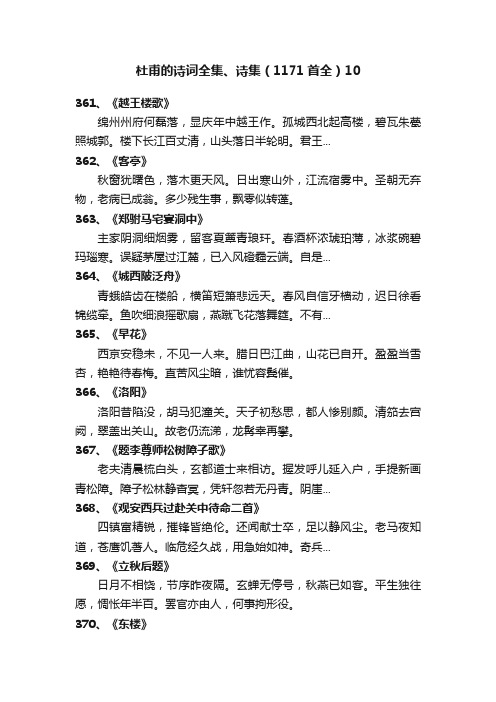
杜甫的诗词全集、诗集(1171首全)10361、《越王楼歌》绵州州府何磊落,显庆年中越王作。
孤城西北起高楼,碧瓦朱甍照城郭。
楼下长江百丈清,山头落日半轮明。
君王...362、《客亭》秋窗犹曙色,落木更天风。
日出寒山外,江流宿雾中。
圣朝无弃物,老病已成翁。
多少残生事,飘零似转蓬。
363、《郑驸马宅宴洞中》主家阴洞细烟雾,留客夏簟青琅玕。
春酒杯浓琥珀薄,冰浆碗碧玛瑙寒。
误疑茅屋过江麓,已入风磴霾云端。
自是...364、《城西陂泛舟》青蛾皓齿在楼船,横笛短箫悲远天。
春风自信牙樯动,迟日徐看锦缆牵。
鱼吹细浪摇歌扇,燕蹴飞花落舞筵。
不有...365、《早花》西京安稳未,不见一人来。
腊日巴江曲,山花已自开。
盈盈当雪杏,艳艳待春梅。
直苦风尘暗,谁忧容鬓催。
366、《洛阳》洛阳昔陷没,胡马犯潼关。
天子初愁思,都人惨别颜。
清笳去宫阙,翠盖出关山。
故老仍流涕,龙髯幸再攀。
367、《题李尊师松树障子歌》老夫清晨梳白头,玄都道士来相访。
握发呼儿延入户,手提新画青松障。
障子松林静杳冥,凭轩忽若无丹青。
阴崖...368、《观安西兵过赴关中待命二首》四镇富精锐,摧锋皆绝伦。
还闻献士卒,足以静风尘。
老马夜知道,苍鹰饥著人。
临危经久战,用急始如神。
奇兵...369、《立秋后题》日月不相饶,节序昨夜隔。
玄蝉无停号,秋燕已如客。
平生独往愿,惆怅年半百。
罢官亦由人,何事拘形役。
370、《东楼》万里流沙道,西征过北门。
但添新战骨,不返旧征魂。
楼角临风迥,城阴带水昏。
传声看驿使,送节向河源。
371、《又示宗武》觅句新知律,摊书解满床。
试吟青玉案,莫羡紫罗囊。
假日从时饮,明年共我长。
应须饱经术,已似爱文章。
十五...372、《赠崔十三评事公辅》飘飘西极马,来自渥洼池。
飒飁定山桂,低徊风雨枝。
我闻龙正直,道屈尔何为。
且有元戎命,悲歌识者谁。
官联...373、《万丈潭》青溪合冥莫,神物有显晦。
龙依积水蟠,窟压万丈内。
跼步凌垠堮,侧身下烟霭。
前临洪涛宽,却立苍石大。
杜甫诗歌汇总
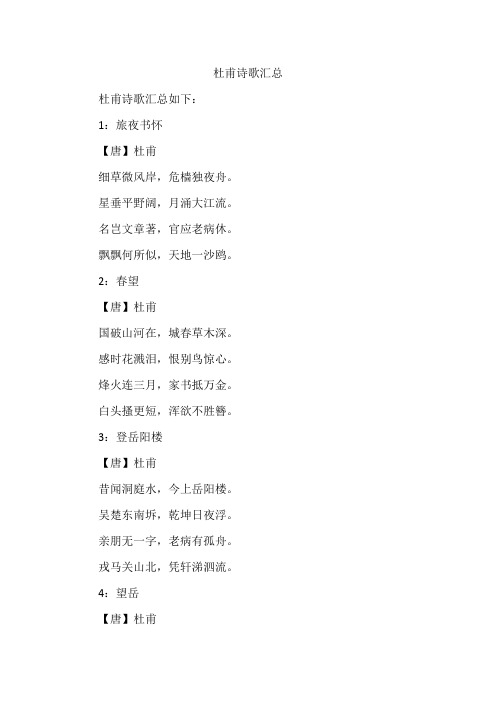
杜甫诗歌汇总杜甫诗歌汇总如下:1:旅夜书怀【唐】杜甫细草微风岸,危樯独夜舟。
星垂平野阔,月涌大江流。
名岂文章著,官应老病休。
飘飘何所似,天地一沙鸥。
2:春望【唐】杜甫国破山河在,城春草木深。
感时花溅泪,恨别鸟惊心。
烽火连三月,家书抵万金。
白头搔更短,浑欲不胜簪。
3:登岳阳楼【唐】杜甫昔闻洞庭水,今上岳阳楼。
吴楚东南坼,乾坤日夜浮。
亲朋无一字,老病有孤舟。
戎马关山北,凭轩涕泗流。
4:望岳【唐】杜甫岱宗夫如何?齐鲁青未了。
造化钟神秀,阴阳割昏晓。
荡胸生层云,决眦入归鸟。
会当凌绝顶,一览众山小。
5:月夜【唐】杜甫今夜鄜州月,闺中只独看。
遥怜小儿女,未解忆长安。
香雾云鬟湿,清辉玉臂寒。
何时倚虚幌,双照泪痕干。
6:天末怀李白【唐】杜甫凉风起天末,君子意如何。
鸿雁几时到,江湖秋水多。
文章憎命达,魑魅喜人过。
应共冤魂语,投诗赠汨罗。
7:《春夜喜雨》好雨知时节,当春乃发生。
随风潜入夜,润物细无声。
野径云俱黑,江船火独明。
晓看红湿处,花重锦官城。
8:《登高》风急天高猿啸哀,渚清沙白鸟飞回。
无边落木萧萧下,不尽长江滚滚来。
万里悲秋常作客,百年多病独登台。
艰难苦恨繁霜鬓,潦倒新停浊酒杯。
9:《闻官军收河南河北》剑外忽传收蓟北,初闻涕泪满衣裳。
却看妻子愁何在,漫卷诗书喜欲狂。
白日放歌须纵酒,青春作伴好还乡。
即从巴峡穿巫峡,便下襄阳向洛阳。
10:《茅屋为秋风所破歌》八月秋高风怒号,卷我屋上三重茅。
茅飞渡江洒江郊,高者挂罥长林梢,下者飘转沉塘坳。
南村群童欺我老无力,忍能对面为盗贼,公然抱茅入竹去。
唇焦口燥呼不得,归来倚杖自叹息。
俄顷风定云墨色,秋天漠漠向昏黑。
布衾多年冷似铁,娇儿恶卧踏里裂。
床头屋漏无干处,雨脚如麻未断绝。
自经丧乱少睡眠,长夜沾湿何由彻?安得广厦千万间,大庇天下寒士俱欢颜,风雨不动安如山。
呜呼!何时眼前突兀见此屋,吾庐独破受冻死亦足!。
杜甫的诗词全集、诗集(1171首全)26
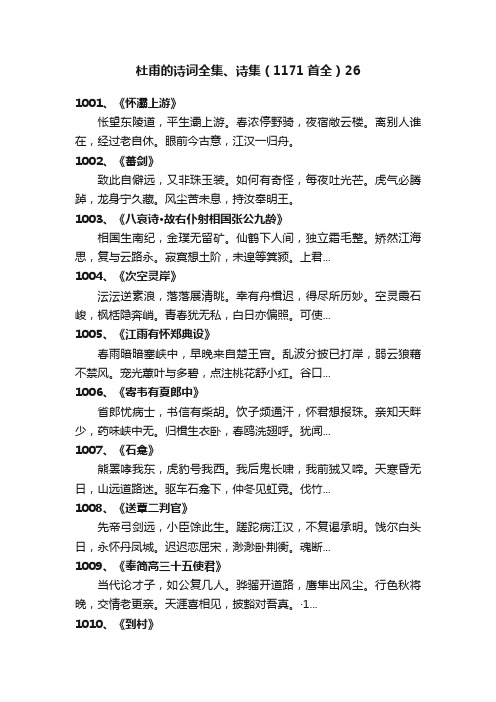
杜甫的诗词全集、诗集(1171首全)261001、《怀灞上游》怅望东陵道,平生灞上游。
春浓停野骑,夜宿敞云楼。
离别人谁在,经过老自休。
眼前今古意,江汉一归舟。
1002、《蕃剑》致此自僻远,又非珠玉装。
如何有奇怪,每夜吐光芒。
虎气必腾踔,龙身宁久藏。
风尘苦未息,持汝奉明王。
1003、《八哀诗·故右仆射相国张公九龄》相国生南纪,金璞无留矿。
仙鹤下人间,独立霜毛整。
矫然江海思,复与云路永。
寂寞想土阶,未遑等箕颍。
上君...1004、《次空灵岸》沄沄逆素浪,落落展清眺。
幸有舟楫迟,得尽所历妙。
空灵霞石峻,枫栝隐奔峭。
青春犹无私,白日亦偏照。
可使...1005、《江雨有怀郑典设》春雨暗暗塞峡中,早晚来自楚王宫。
乱波分披已打岸,弱云狼藉不禁风。
宠光蕙叶与多碧,点注桃花舒小红。
谷口...1006、《寄韦有夏郎中》省郎忧病士,书信有柴胡。
饮子频通汗,怀君想报珠。
亲知天畔少,药味峡中无。
归楫生衣卧,春鸥洗翅呼。
犹闻...1007、《石龛》熊罴哮我东,虎豹号我西。
我后鬼长啸,我前狨又啼。
天寒昏无日,山远道路迷。
驱车石龛下,仲冬见虹霓。
伐竹...1008、《送覃二判官》先帝弓剑远,小臣馀此生。
蹉跎病江汉,不复谒承明。
饯尔白头日,永怀丹凤城。
迟迟恋屈宋,渺渺卧荆衡。
魂断...1009、《奉简高三十五使君》当代论才子,如公复几人。
骅骝开道路,鹰隼出风尘。
行色秋将晚,交情老更亲。
天涯喜相见,披豁对吾真。
·1...1010、《到村》碧涧虽多雨,秋沙先少泥。
蛟龙引子过,荷芰逐花低。
老去参戎幕,归来散马蹄。
稻粱须就列,榛草即相迷。
蓄积...1011、《又作此奉卫王》西北楼成雄楚都,远开山岳散江湖。
二仪清浊还高下,三伏炎蒸定有无。
推毂几年唯镇静,曳裾终日盛文儒。
白头...1012、《雨二首》青山澹无姿,白露谁能数。
片片水上云,萧萧沙中雨。
殊俗状巢居,曾台俯风渚。
佳客适万里,沈思情延伫。
挂帆...1013、《西阁二首》巫山小摇落,碧色见松林。
值得珍藏的《杜甫诗词全集》(1168首)

值得珍藏的《杜甫诗词全集》(1168首)
•《浣溪沙》
•《浣溪沙》
•《秋兴八首》
•《旅夜书怀》
•《月夜》
•《客至》
•《江南逢李龟年》•《阁夜》
•《清明》
•《饮中八仙歌》
•《丽人行》
•《佳人》
•《八阵图》
•《登楼》
•《月夜忆舍弟》
•《自京赴奉先县咏怀..》•《新婚别》
•《赠花卿》
•《哀江头》
•《北征》
•《戏为六绝句》
•《羌村三首》
•《江村》
•《野望》
•《野望》
•《野望》
•《野望》
•《野望》
•《即事》
•《即事》
•《天末怀李白》•《新安吏》
•《又呈吴郎》
•《春宿左省》
•《宿府》
•《雨》
•《雨》
•《雨》
•《雨》
•《雨》
•《雨》
•《春日忆李白》•《古柏行》
•《江汉》
•《九日》
•《无家别》
•《丹青引赠曹将军霸》•《哀王孙》
•《对雪》
•《曲江二首》
•《对雪》
•《别房太尉墓》•《咏怀古迹五首》•《遣兴》
•《遣兴》
•《月》
•《月》
•《洗兵马》
•《恨别》。
杜甫诗词大全集
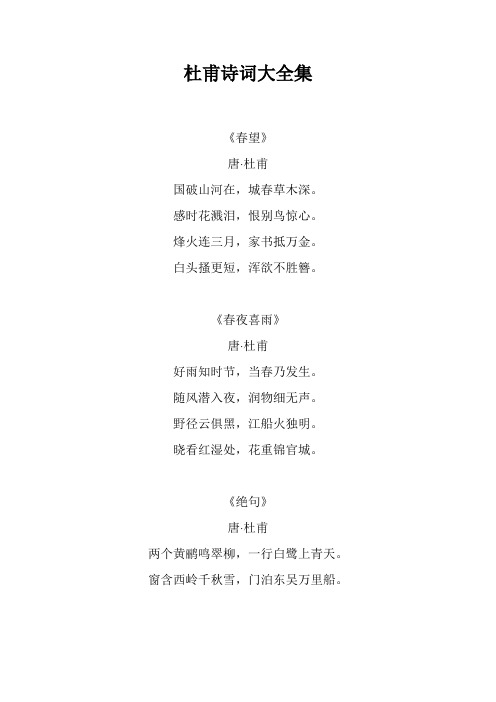
杜甫诗词大全集《春望》唐·杜甫国破山河在,城春草木深。
感时花溅泪,恨别鸟惊心。
烽火连三月,家书抵万金。
白头搔更短,浑欲不胜簪。
《春夜喜雨》唐·杜甫好雨知时节,当春乃发生。
随风潜入夜,润物细无声。
野径云俱黑,江船火独明。
晓看红湿处,花重锦官城。
《绝句》唐·杜甫两个黄鹂鸣翠柳,一行白鹭上青天。
窗含西岭千秋雪,门泊东吴万里船。
《望岳》唐·杜甫岱宗夫如何?齐鲁青未了。
造化钟神秀,阴阳割昏晓。
荡胸生曾云,决眦入归鸟。
会当凌绝顶,一览众山小。
《闻官军收河南河北》唐·杜甫剑外忽传收蓟北,初闻涕泪满衣裳。
却看妻子愁何在,漫卷诗书喜欲狂。
白日放歌须纵酒,青春作伴好还乡。
即从巴峡穿巫峡,便下襄阳向洛阳。
《登高》唐·杜甫风急天高猿啸哀,渚清沙白鸟飞回。
无边落木萧萧下,不尽长江滚滚来。
万里悲秋常作客,百年多病独登台。
艰难苦恨繁霜鬓,潦倒新停浊酒杯。
《月夜忆舍弟》唐·杜甫戍鼓断人行,边秋一雁声。
露从今夜白,月是故乡明。
有弟皆分散,无家问死生。
寄书长不达,况乃未休兵。
《蜀相》唐·杜甫丞相祠堂何处寻,锦官城外柏森森。
映阶碧草自春色,隔叶黄鹂空好音。
三顾频烦天下计,两朝开济老臣心。
出师未捷身先死,长使英雄泪满襟。
杜甫的诗全集

杜甫的诗全集杜甫的诗全集杜甫是一位现实主义作家,一提杜甫,就能想到教科书里的那个小老头,眉头紧锁,忧国忧民。
杜甫是我国的八大诗人之一,下面是小编整理的杜甫的`诗全集,欢迎阅读。
故右仆射相国张公九龄唐· 杜甫相国生南纪,金璞无留矿。
仙鹤下人间,独立霜毛整。
矫然江海思,复与云路永。
寂寞想土阶,未遑等箕颍。
上君白玉堂,倚君金华省。
碣石岁峥嵘,天地日蛙黾。
送高司直寻封阆州唐· 杜甫丹雀衔书来,暮栖何乡树。
骅骝事天子,辛苦在道路。
司直非冗官,荒山甚无趣。
借问泛舟人,胡为入云雾。
与子姻娅间,既亲亦有故。
万里长江边,邂逅一相遇。
长卿消渴再,公干沉绵屡。
清谈慰老夫,开卷得佳句。
送顾八分文学适洪吉州唐· 杜甫中郎石经后,八分盖憔悴。
顾侯运炉锤,笔力破馀地。
昔在开元中,韩蔡同赑屃。
玄宗妙其书,是以数子至。
御札早流传,揄扬非造次。
三人并入直,恩泽各不二。
顾于韩蔡内,辨眼工小字。
分日示诸王,钩深法更秘。
送韩十四江东省觐唐· 杜甫兵戈不见老莱衣,叹息人间万事非。
我已无家寻弟妹,君今何处访庭闱。
黄牛峡静滩声转,白马江寒树影稀。
此别应须各努力,故乡犹恐未同归。
送翰林张司马南海勒碑唐· 杜甫冠冕通南极,文章落上台。
诏从三殿去,碑到百蛮开。
野馆浓花发,春帆细雨来。
不知沧海上,天遣几时回。
送何侍御归朝唐· 杜甫舟楫诸侯饯,车舆使者归。
山花相映发,水鸟自孤飞。
春日垂霜鬓,天隅把绣衣。
故人从此去,寥落寸心违。
送贾阁老出汝州唐· 杜甫西掖梧桐树,空留一院阴。
艰难归故里,去住损春心。
宫殿青门隔,云山紫逻深。
人生五马贵,莫受二毛侵。
送孔巢父谢病归游江东唐· 杜甫巢父掉头不肯住,东将入海随烟雾。
诗卷长留天地间,钓竿欲拂珊瑚树。
深山大泽龙蛇远,春寒野阴风景暮。
蓬莱织女回云车,指点虚无是征路。
自是君身有仙骨,世人那得知其故。
惜君只欲苦死留,富贵何如草头露。
送李八秘书赴杜相公幕唐· 杜甫青帘白舫益州来,巫峡秋涛天地回。
杜甫的诗全集

杜甫的诗全集导读:古诗词大全杜甫的诗全集
【篇一:《江南逢李龟年》】
岐王宅里寻常见,崔九堂前几度闻。
正是江南好风景,落花时节又逢君。
【篇二:《寒食》】
寒食江村路,风花高下飞。
汀烟轻冉冉,竹日静晖晖。
田父要皆去,邻家闹不违。
地偏相识尽,鸡犬亦忘归。
【篇三:《对雪》】
战哭多新鬼,愁吟独老翁。
乱云低薄暮,急雪舞回风。
瓢弃尊无绿,炉存火似红。
数州消息断,愁坐正书空。
【篇四:《旅夜书怀》】细草微风岸,危樯独夜舟。
星垂平野阔,月涌大江流。
名岂文章着,官因老病休。
飘飘何所似,天地一沙鸥。
【篇五:《春日忆李白》】白也诗无敌,飘然思不群。
清新庾开府,俊逸鲍参军。
渭北春天树,江东日暮云。
何时一樽酒,重与细论文。
【篇六:《赠卫八处士》】人生不相见,动如参与商。
今夕复何夕,共此灯烛光。
少壮能几时,鬓发各已苍。
访旧半为鬼,惊呼热中肠。
焉知二十载,重上君子堂。
昔别君未婚,儿女忽成行。
怡然敬父执,问我来何方。
问答乃未已,驱儿罗酒浆。
夜雨剪春韭,新炊间黄粱。
主称会面难,一举累十觞。
十觞亦不醉,感子故意长。
明日隔山岳,世事两茫茫。
感谢您的阅读,本文如对您有帮助,可下载编辑,谢谢。
古诗杜甫大全300首

1、陪李金吾花下饮(唐代-杜甫)胜地初相引,余行得自娱。
见轻吹鸟毳,随意数花须。
细草称偏坐,香醪懒再酤。
醉归应犯夜,可怕李金吾。
2、官定后戏赠(唐代-杜甫)不作河西尉:凄凉为折腰。
老夫怕趋(qū)走,率府且逍遥。
耽(dān)酒须微禄,狂歌托圣朝。
故山归兴尽,回首向风飙(biāo)。
3、端午日赐衣(唐代-杜甫)宫衣亦有名,端午被恩荣。
细葛含风软,香罗叠雪轻。
自天题处湿,当暑著来清。
意内称长短,终身荷圣情。
4、曲江对雨(唐代-杜甫)城上春云覆苑墙,江亭晚色静年芳。
林花著(zhuó)雨胭脂湿,水荇牵风翠带长。
龙武新军深驻辇,芙蓉别殿谩(màn)焚香。
何时诏此金钱会,暂醉佳人锦瑟旁。
5、小至(唐代-杜甫)天时人事日相催,冬至阳生春又来。
刺绣五纹添弱线,吹葭(jiā)六琯(guǎn)动浮灰。
岸容待腊将舒柳,山意冲寒欲放梅。
云物不殊乡国异,教儿且覆(fù)掌中杯。
6、夏日叹(唐代-杜甫)夏日出东北,陵(líng)天经中街。
朱光彻厚地,郁(yù)蒸何由开。
上苍久无雷,无乃号令乖。
雨降不濡(rú)物,良田起黄埃。
飞鸟苦热死,池鱼涸其泥。
万人尚流冗,举目唯蒿(hāo)莱。
至今大河北,化作虎与豺。
浩荡想幽蓟(jì),王师安在哉。
对食不能餐,我心殊未谐。
眇然贞观初,难与数子偕。
7、遣兴(唐代-杜甫)骥(jì)子好男儿,前年学语时。
问知人客姓,诵得老夫诗。
世乱怜渠(qú)小,家贫仰母慈。
鹿门携不遂(suì),雁足系难期。
天地军麾(huī)满,山河战角悲。
傥(tǎng)归免相失,见日敢辞迟。
8、羌村(唐代-杜甫)峥(zhēng)嵘(róng)赤云西,日脚下平地。
柴门鸟雀噪(zào),归客千里至。
妻孥(nú)怪我在,惊定还拭泪。
世乱遭飘荡,生还偶然遂!邻人满墙头,感叹亦歔(xū)欷(xī)。
夜阑(lán)更秉烛,相对如梦寐(mèi)。
杜甫古诗大全300首

杜甫古诗大全300首第1首、短歌行赠王郎司直(唐代-杜甫)王郎酒酣拔剑斫(zhuó)地歌莫哀!我能拔尔抑塞磊落之奇才。
豫章翻风白日动,鲸鱼跋浪沧溟(míng)开。
且脱佩剑休徘(pái)徊(huái)。
西得诸侯棹(zhào)锦水,欲向何门趿(tà)珠履?仲宣楼头春色深,青眼高歌望吾子,眼中之人吾老矣!第2首、潼关吏(唐代-杜甫)士卒何草草,筑城潼关道。
大城铁不如,小城万丈余。
借问潼关吏:修关还备胡?要我下马行,为我指山隅(yú):连云列战格,飞鸟不能逾(yú)。
胡来但自守,岂复忧西都。
丈人视要处,窄狭容单车。
艰难奋长戟(jǐ),万古用一夫。
哀哉桃林战,百万化为鱼。
请嘱防关将,慎勿学哥舒!第3首、寄李十二白二十韵(唐代-杜甫)昔年有狂客,号尔谪(zhé)仙人。
笔落惊风雨,诗成泣鬼神。
声名从此大,汩(gǔ)没一朝伸。
文采承殊渥(wò),流传必绝伦。
龙舟移棹(zhào)晚,兽锦夺袍新。
白日来深殿,青云满后尘。
乞归优诏许,遇我宿心亲。
未负幽栖(qī)志,兼全宠辱身。
剧谈怜野逸,嗜(shì)酒见天真。
醉舞梁园夜,行歌泗(sì)水春。
才高心不展,道屈善无邻。
处士祢(mí)衡俊,诸生原宪(xiàn)贫。
稻粱求未足,薏(yì)苡(yǐ)谤(bàng)何频。
五岭炎蒸地,三危放逐臣。
几年遭鵩(fú)鸟,独泣向麒麟。
苏武先还汉,黄公岂事秦。
楚筵(yán)辞醴(lǐ)日,梁狱上书辰。
已用当时法,谁将此义陈。
老吟秋月下,病起暮江滨。
莫怪恩波隔,乘槎(chá)与问津。
第4首、饮中八仙歌(唐代-杜甫)知章骑马似乘船,眼花落井水底眠。
汝阳三斗始朝天,道逢麴(qū)车口流涎,恨不移封向酒泉。
左相日兴费万钱,饮如长鲸吸百川,衔杯乐圣称避贤。
- 1、下载文档前请自行甄别文档内容的完整性,平台不提供额外的编辑、内容补充、找答案等附加服务。
- 2、"仅部分预览"的文档,不可在线预览部分如存在完整性等问题,可反馈申请退款(可完整预览的文档不适用该条件!)。
- 3、如文档侵犯您的权益,请联系客服反馈,我们会尽快为您处理(人工客服工作时间:9:00-18:30)。
“Parent” Study Findings
No significant reduction in pregnancy rates in pharmacy access and advance provision groups
Measures
Outcome Measure (Follow-up visit): o EC use
Main Predictor Measures (Baseline visit): o Previous pregnancy (yes/no) o Previous abortion (yes/no-includes those who have been pregnant, but not had an abortion and those who have not been pregnant)
Emergency contraception [EC] has the potential to prevent 50% of these pregnancies and 60-70% of abortions annually. (Trussel 1992)
EC is effective when taken 72 to 120 hours after intercourse, but is most effective the sooner it is taken. (Ellertson 2003)
Data were not collected to test my hypotheses
Conclusions
Increased rates of unprotected intercourse and increased EC use among young women with previous pregnancies and abortions (may cancel each other out)
Study Hypotheses
1) Young women who have experienced pregnancy are more likely to use EC, than young women who have not experienced pregnancy.
2) Among young women who have experienced pregnancy, those who have experienced abortion are more likely to use EC, than young women who have not experienced abortion, who may or may not have experienced pregnancy.
No increase in STIs No differences by study group in:
o contraceptive patterns o condom use o sexual behaviors
EC use during the study N=571 (26.9%)
“The public health impact may be negligible because of high rates of unprotected intercourse and relative underutilization of the method.”
Multivariate logistic regression: Impact of previous pregnancy/abortion (and other predictors) on EC use during the study (adjusted).
Results:
Previous Pregnancy
Raine TR, Harper CC, Rocca CH, Fischer R, Padian N, Klausner JD, Darney PD. Direct access to emergency contraception through pharmacies and effect on unintended pregnancy and STIs: a randomized, controlled trial. JAMA 2005; 293: 54–62.
“Parent” Study Design & Setting
A randomized, single-blind, controlled trial Conducted by investigators at UCSF July 2001 to June 2003 at four California clinics
Pregnancy Experience &
Use of Emergency Contraception
Among Young Women in the Bay Area
Shira Rutman June 2006
Significance
Three and a half million unintended pregnancies occur each year in the United States. (Henshaw 1998)
Participants continued
Not pregnant or desiring pregnancy Not using long-term hormonal
contraception (injectables, IUD or implants) Not requesting EC at the enrollment Had not had unprotected intercourse in the
Participants
Young women 15-24 years old Spoke English or Spanish Had sexual intercourse in the previous six
months (“sexually active”) Lived in the San Francisco Bay Area Available for follow-up 6 months later
Results:
Previous Abortion
Of the 686 (32.4%) participants who reported pregnancy at baseline, 562 (81.9%) reported that they had had an abortion.
Used EC during study N=167 (29.2%) Chi-square tests showed significant differences
Methods
Chi-square tests: Differences between previous pregnancy/abortion and no previous pregnancy/abortion groups.
Crude odds ratios: Association between previous pregnancy/abortion and characteristics of participants at enrollment (demographics, contraceptive/sexual behaviors and pregnancy attitudes).
Previous pregnancy N=686 (32.4%) Used EC during study (outcome) N=200 (35.0%) Chi-square tests showed significant differences
between pregnancy experience groups in every characteristic exato EC (study arm)
providing family planning services Three arms: advance provision, pharmacy access
and clinic (control) Examined reproductive outcomes (pregnancy,
STIs and contraceptive/sexual behaviors Total N=2,117
Measures continued
Predictor Measures: o Level of access to EC (study arm) o Clinic site (enrollment site) o Age (continuous) o Race/Ethnicity o Ever used EC (yes/no) o Frequency of intercourse o Unprotected intercourse past 6 mos (yes/no) o Contraceptive method o Pregnancy Attitude (very unhappy/other)
Multivariate Logistic Regression:
Previous Pregnancy
Odds of EC use: Unprotected intercourse Ever used EC OC use and use of both OC and condoms
*Adjusted for all the other variables
between abortion experience groups in every characteristic examined except for level of access to EC (study arm) and clinic site.
